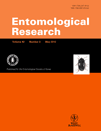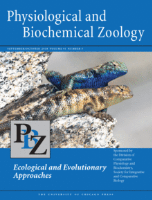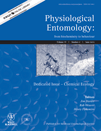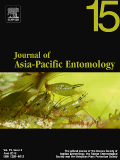
JOURNAL OF INSECT PHYSIOLOGY
Scope & Guideline
Advancing Knowledge in Insect Physiology
Introduction
Aims and Scopes
- Insect Physiology and Biochemistry:
Research on the physiological mechanisms and biochemical pathways that sustain insect life, including metabolism, growth, reproduction, and stress responses. - Ecophysiology:
Studies on how insects interact with their environment, including responses to climate change, habitat alterations, and resource availability. - Neurophysiology:
Investigations into the nervous system function of insects, encompassing behavior, sensory processing, and neurochemical regulation. - Developmental Physiology:
Exploration of the physiological changes during various life stages of insects, including metamorphosis and diapause. - Molecular Physiology:
Focus on the molecular mechanisms underlying physiological processes, employing techniques such as gene editing and transcriptomics. - Insect-Host Interactions:
Research on the physiological aspects of interactions between insects and their hosts, including parasitism, mutualism, and predation. - Environmental Physiology:
Examination of how insects adapt physiologically to environmental stressors such as temperature extremes, humidity fluctuations, and pollutants.
Trending and Emerging
- Climate Change Impacts:
Research on how climate change affects insect physiology, behavior, and ecology is increasingly prominent, addressing the urgent need to understand insect responses to global warming. - Microbiome and Insect Health:
Studies exploring the role of microbiota in insect physiology and health are emerging, highlighting the significance of gut microbes in metabolic processes and disease resistance. - Genetic and Genomic Approaches:
There is a noticeable trend towards utilizing genetic and genomic tools, such as CRISPR/Cas9, to study physiological processes, reflecting advancements in molecular biology. - Physiological Mechanisms of Insect-Pathogen Interactions:
Research focused on how insects respond physiologically to pathogens and parasites is gaining traction, aiming to improve pest management strategies. - Behavioral Physiology:
Increased interest in the physiological basis of insect behavior, including foraging, mating, and social interactions, is evident, bridging the gap between physiology and ethology. - Sustainable Insect Management:
Research addressing the physiological aspects of pest management strategies that are environmentally sustainable and that consider insect welfare is on the rise.
Declining or Waning
- Traditional Toxicology Studies:
Research centered on the toxicological effects of chemicals on insects has seen a decline, possibly due to increasing interest in integrated pest management and sustainable practices. - Static Taxonomic Studies:
Papers focused solely on the classification and description of new insect species without physiological context are less common, as the field moves towards more integrative approaches. - Basic Morphological Studies:
Research that primarily investigates the morphology of insects without linking it to physiological or ecological implications is becoming less prevalent as the emphasis shifts to functional morphology. - Historical Physiology:
Studies that explore historical aspects of insect physiology, such as evolutionary perspectives without direct experimental data, are diminishing in favor of more contemporary research approaches.
Similar Journals

ENTOMOLOGICAL RESEARCH
Pioneering Discoveries in Biodiversity and Insect ImpactENTOMOLOGICAL RESEARCH, published by Wiley, is a prominent journal within the field of Insect Science, with a significant focus on advancing our understanding of entomological studies, including pest management, biodiversity, and ecological impacts of insects. Since its inception in 2007, the journal has served as a vital platform for researchers and practitioners to publish high-quality, peer-reviewed articles that contribute to the growing body of knowledge in this essential discipline. With an H-index illustrating its citation impact and its classification in the 2023 Scopus quartile rankings at Q3, ENTOMOLOGICAL RESEARCH ranks 69 out of 181 journals in its field, positioning itself within the 62nd percentile, which underscores its relevance and contribution to agricultural and biological sciences. Although it does not offer Open Access, the journal remains committed to ensuring that its content reaches the widest possible audience, supporting ongoing discoveries and innovations in insect science. For researchers, professionals, and students seeking to remain at the forefront of entomological advancements, ENTOMOLOGICAL RESEARCH is an indispensable resource.

Physiological Reviews
Illuminating the Complexities of Life Through PhysiologyPhysiological Reviews is a prestigious journal published by the American Physiological Society, dedicated to advancing our understanding of physiology across various domains. With an impressive impact factor that places it in Q1 quartiles for medicine, molecular biology, and physiology as of 2023, this journal is recognized as a leading source of high-quality reviews and research analyses. The journal has been a vital resource for the scientific community since its inception in 1945, providing in-depth and comprehensive insights that are crucial for both scholars and practitioners in the field. Although not an open-access publication, it remains widely accessible through institutional subscriptions, ensuring that crucial research findings are disseminated efficiently. With Scopus rankings that place it in the top percentile across multiple categories, Physiological Reviews continues to be an essential platform for the latest advancements and discoveries in physiology, making it indispensable for researchers, professionals, and students alike.

Physiological Reports
Transforming Physiological Understanding for a Global AudiencePhysiological Reports is a pioneering open-access journal published by WILEY, dedicated to advancing the field of physiology through the dissemination of high-quality research. Since its inception in 2013, this journal has provided a platform for innovative studies in both general physiology and medical physiology, making significant contributions to our understanding of biological processes. With an impact factor that reflects its growing influence—as evidenced by its placement in the Q2 category for physiology and medical physiology in 2023—Physiological Reports is positioned as a vital resource for researchers and practitioners alike. The journal encourages the submission of diverse studies ranging from cellular mechanisms to systemic physiology, presenting a unique opportunity for authors to reach a global audience without access barriers. It has established a reputation for rigorous peer review and timely publication, ensuring that cutting-edge research is readily available to stimulate further inquiry and collaboration in the scientific community.

PHYSIOLOGICAL AND BIOCHEMICAL ZOOLOGY
Connecting Physiology, Biochemistry, and ZoologyPhysiological and Biochemical Zoology is a distinguished peer-reviewed journal published by University of Chicago Press, focusing on the interrelated fields of animal physiology, biochemistry, and zoology. With a strong commitment to advancing scientific understanding, this journal serves as a vital resource for researchers, professionals, and students alike, providing a platform for the latest findings and advancements in the field. Ranking in the top quartile (Q1) in Animal Science and Zoology as of 2023, and showcasing a substantial convergence of historical data from 1999 to 2023, its impact in the academic community is underscored by its engagement with high-quality research. While it also appears in the third quartile for Biochemistry and Physiology, the journal successfully integrates these disciplines, reflecting the complexity of biological systems. Available for reading via various access options, this journal is essential for anyone seeking to deepen their knowledge or contribute to the field of Zoological sciences.

PHYSIOLOGICAL ENTOMOLOGY
Decoding the Dynamics of Insect BehaviorPHYSIOLOGICAL ENTOMOLOGY is a prestigious journal published by WILEY, focusing on the intricate relationships between physiological processes and the ecological and evolutionary dynamics of insects. With an ISSN of 0307-6962 and E-ISSN of 1365-3032, this journal has been at the forefront of insect science since its inception in 1976, contributing significantly to the understanding of insect physiology and behavior. The journal has established itself within the academic community, currently holding a position in the Q2 quartile for both Ecology, Evolution, Behavior and Systematics and Insect Science, highlighting its relevance and impact in these fields. Although there are no Open Access options available, researchers and practitioners can rely on its regular publications to stay abreast of pivotal discoveries and methodologies in insect physiology. With a commitment to advancing the field through rigorous peer-reviewed research, PHYSIOLOGICAL ENTOMOLOGY serves as an essential resource for researchers, professionals, and students alike.

BIOLOGIA PLANTARUM
Advancing Plant Science for a Sustainable FutureBIOLOGIA PLANTARUM, esteemed within the realms of horticulture and plant science, is a leading academic journal published by the Academy of Sciences of the Czech Republic, Institute of Experimental Botany. Established in 1959, this journal showcases innovative research and advancements in plant biology, focusing on a spectrum of topics including plant physiology, genetics, and biotechnology. With an impressive Scopus ranking in Horticulture (Rank #41/115) and Plant Science (Rank #221/516), it holds a significant place in the academic community, reflected in its Q2 and Q3 status within its respective categories. Although it is not open access, authors are encouraged to contribute to the growing body of knowledge that supports sustainable practices in agriculture and horticulture. Published in the Netherlands, BIOLOGIA PLANTARUM continues to foster collaboration and dialogue among researchers, professionals, and students dedicated to understanding and advancing plant sciences.

PFLUGERS ARCHIV-EUROPEAN JOURNAL OF PHYSIOLOGY
Pioneering Discoveries in European PhysiologyPflügers Archiv - European Journal of Physiology, published by Springer Heidelberg, stands at the forefront of physiological research, showcasing groundbreaking studies since its inception in the 1950s. With a distinguished ISSN of 0031-6768 and an E-ISSN of 1432-2013, this esteemed journal maintains a robust reputation, holding Q1 rankings in Clinical Biochemistry, Physiology, and Medical Physiology as of 2023. Its impressive Scopus rankings place it in the top percentile across various categories, including Biochemistry, Genetics and Molecular Biology and Medicine. Pflügers Archiv serves as a vital platform for researchers, professionals, and students, facilitating the dissemination and discussion of advanced physiological concepts and methodologies. Although it does not currently offer open access, its rigorous peer-review process ensures the highest quality publications that contribute significantly to our understanding of physiological science. Explore the depth of physiological research that shapes our academic landscape today.

JOURNAL OF ASIA-PACIFIC ENTOMOLOGY
Unveiling the Secrets of Insects for a Sustainable TomorrowJOURNAL OF ASIA-PACIFIC ENTOMOLOGY, published by the Korean Society of Applied Entomology, is a distinguished platform that fosters the advancement of knowledge in the field of entomology, specifically tailored to the Asia-Pacific region. Since its inception in 1998, this journal has been instrumental in providing critical insights into the diverse aspects of insect science, reflecting its commitment to supporting both research and application in a variety of contexts, including agriculture and environmental sustainability. The journal is categorized in the Q3 quartile for Insect Science according to the 2023 rankings, and it holds a respectable Scopus rank of #62 out of 181 in its niche, situating it within the top 66th percentile of its field. With a focus on peer-reviewed research that emphasizes innovation and practical applications, the journal serves as an essential resource for researchers, professionals, and students seeking to deepen their understanding of entomological studies and their implications across ecological and agricultural landscapes.

Insects is a prominent open-access journal published by MDPI, dedicated to advancing research in the vibrant field of insect science. Since its inception in 2011, this journal has become a vital resource for academics and professionals alike, also ranked in the prestigious Q1 category within the Insect Science field by Scopus, achieving a remarkable rank of 26 out of 181 journals. With an ongoing convergence period from 2010 to 2024, Insects provides comprehensive coverage of various aspects of entomology, including but not limited to ecology, behavior, physiology, and applied entomology. Based in Switzerland, the journal promotes an open-access model, ensuring that vital research is readily available to researchers, practitioners, and students globally. This journal not only facilitates the dissemination of groundbreaking entomological research but also fosters collaboration and interdisciplinary dialogue in the field.

NEW PHYTOLOGIST
Pioneering Research to Sustain Our FutureNEW PHYTOLOGIST is a premier international journal published by WILEY, focusing on the field of plant science and physiology. Operating since 1902, this esteemed journal has established itself as a vital resource for researchers and professionals alike, offering cutting-edge research and insights into the complex workings of plants and their physiological processes. With an impressive impact factor and recognized in the top quartile (Q1) of both the physiology and plant science categories, it ranks #8 and #9 respectively in their fields, placing it within the top 2% of journals. NEW PHYTOLOGIST is not only essential for enhancing the understanding of plant biology but also for addressing global challenges such as food security and environmental sustainability. Although it does not currently offer open access, the journal remains committed to disseminating knowledge to a wide audience through institutional subscriptions and partnerships. This journal continues to drive advancements in plant science into the future, making it an invaluable asset for students, researchers, and industry professionals.